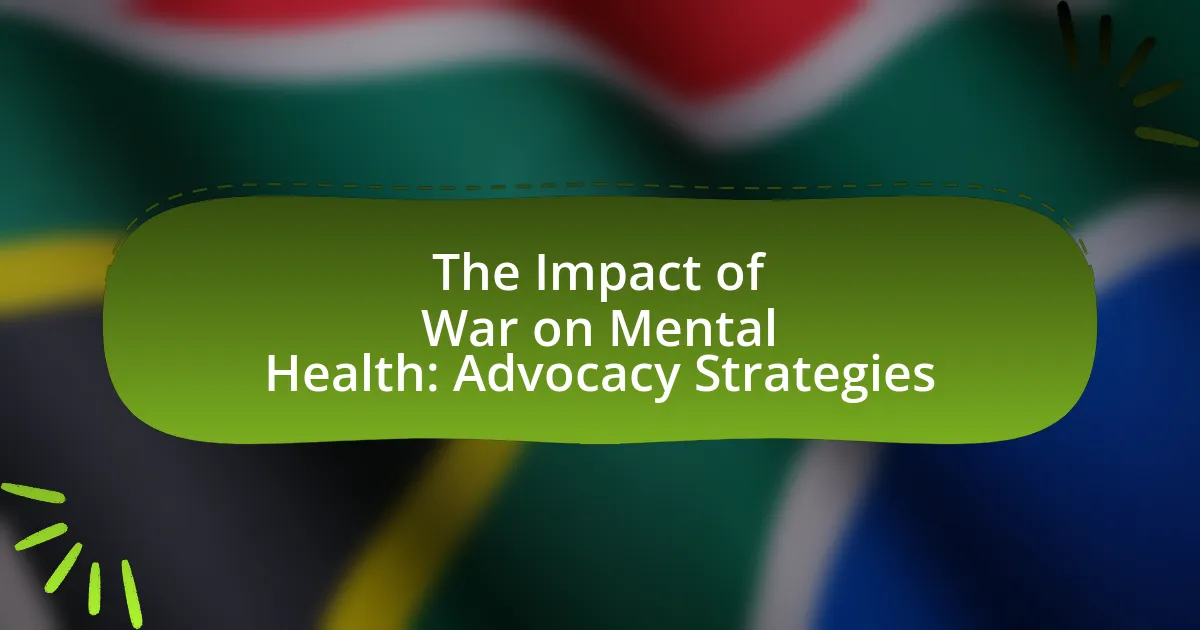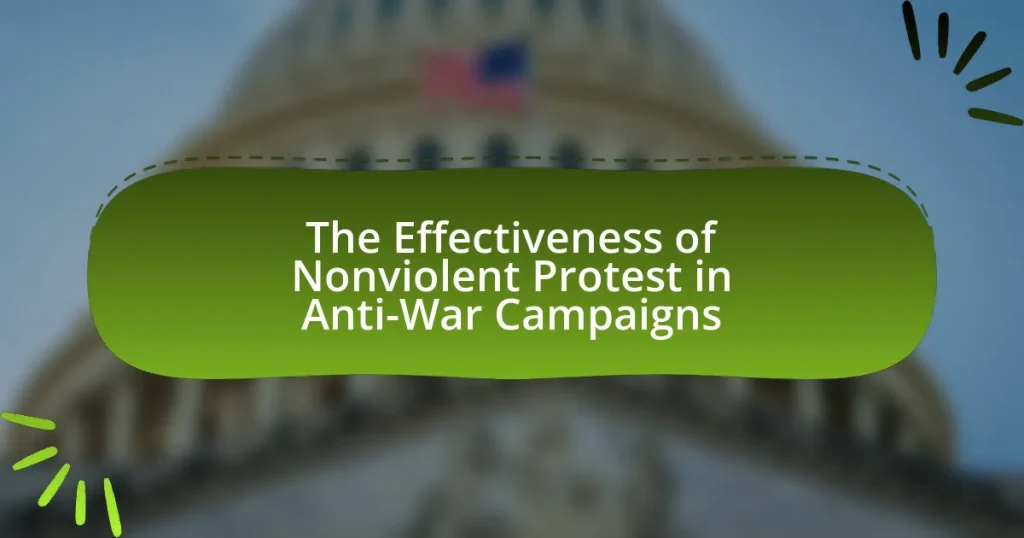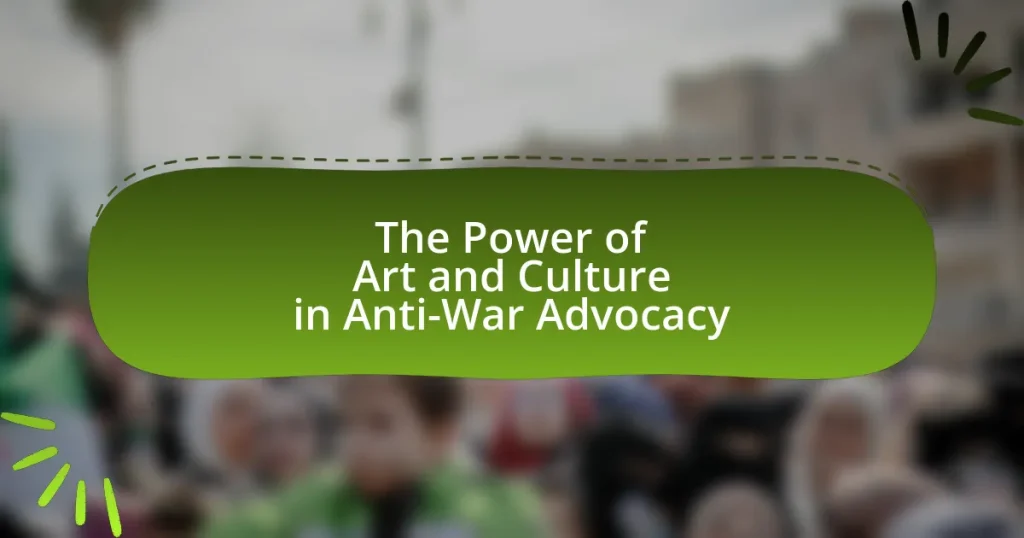The article examines the significant impact of war on mental health, highlighting the prevalence of disorders such as post-traumatic stress disorder (PTSD), depression, and anxiety among both veterans and civilians. It presents research findings indicating that approximately 20% of veterans experience PTSD, with even higher rates among those in conflict zones. The article emphasizes the importance of understanding these mental health challenges to inform effective advocacy strategies, which include raising awareness, promoting access to mental health services, and integrating mental health into humanitarian responses. Additionally, it discusses the role of societal perceptions, community support, and policy in enhancing mental health outcomes for war-affected individuals.
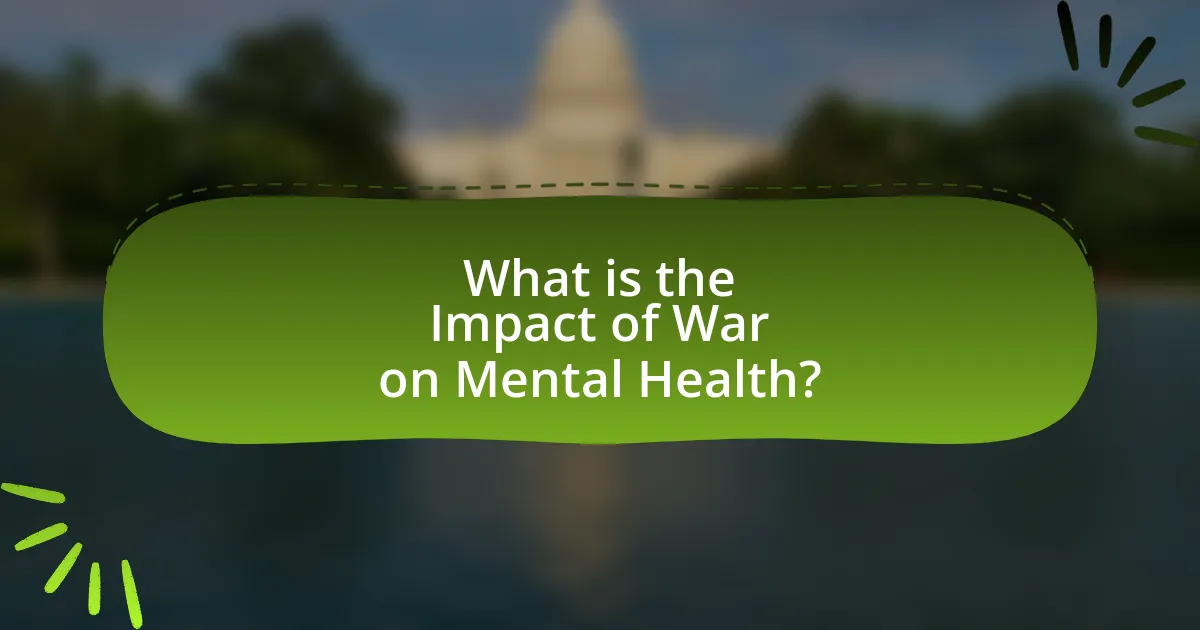
What is the Impact of War on Mental Health?
The impact of war on mental health is profound, leading to increased rates of conditions such as post-traumatic stress disorder (PTSD), depression, and anxiety among combatants and civilians. Research indicates that approximately 20% of veterans experience PTSD, and the prevalence of mental health disorders can be significantly higher in war-affected populations due to exposure to violence, loss, and displacement. For instance, a study published in the Journal of the American Medical Association found that nearly 30% of individuals in conflict zones exhibit symptoms of depression and anxiety. This data underscores the critical need for mental health support and advocacy strategies to address the psychological consequences of war.
How does war influence psychological well-being?
War significantly influences psychological well-being by increasing the prevalence of mental health disorders such as PTSD, anxiety, and depression among affected populations. Research indicates that exposure to combat, loss of loved ones, and displacement can lead to long-term psychological trauma. For instance, a study published in the Journal of the American Medical Association found that nearly 30% of veterans returning from Iraq and Afghanistan experienced PTSD, highlighting the severe impact of war on mental health. Additionally, civilians in war-torn regions often face chronic stress, leading to a decline in overall mental health and well-being.
What are the common mental health disorders associated with war?
Common mental health disorders associated with war include post-traumatic stress disorder (PTSD), depression, anxiety disorders, and substance use disorders. PTSD is particularly prevalent among veterans and civilians exposed to combat, with studies indicating that approximately 20% of veterans experience this condition. Depression and anxiety disorders often arise due to the stress and trauma of war, affecting both soldiers and affected populations. Substance use disorders can also increase as individuals attempt to cope with the psychological impact of war. These disorders are documented in various studies, including the National Vietnam Veterans Readjustment Study, which highlights the long-term mental health effects of combat exposure.
How do combat experiences affect veterans’ mental health?
Combat experiences significantly affect veterans’ mental health, often leading to conditions such as post-traumatic stress disorder (PTSD), depression, and anxiety. Research indicates that approximately 11-20% of veterans who served in Iraq and Afghanistan experience PTSD in a given year, according to the U.S. Department of Veterans Affairs. These mental health issues arise from exposure to traumatic events, including combat, which can result in lasting psychological scars. The impact of these experiences can hinder veterans’ ability to reintegrate into civilian life, affecting relationships, employment, and overall well-being.
Why is understanding the impact of war on mental health important?
Understanding the impact of war on mental health is crucial because it directly affects the well-being of individuals and communities involved in or affected by conflict. Research indicates that exposure to war can lead to a range of mental health issues, including post-traumatic stress disorder (PTSD), depression, and anxiety, with studies showing that up to 30% of veterans experience these conditions. Furthermore, understanding these impacts informs effective advocacy strategies, enabling policymakers and mental health professionals to develop targeted interventions that address the specific needs of affected populations. This knowledge is essential for promoting recovery and resilience in war-impacted communities.
What are the long-term effects of untreated mental health issues from war?
Untreated mental health issues from war can lead to chronic psychological conditions, including post-traumatic stress disorder (PTSD), depression, and anxiety disorders. These conditions can persist for years, significantly impairing an individual’s ability to function in daily life, maintain relationships, and secure employment. Research indicates that veterans with untreated PTSD are at a higher risk for substance abuse, suicidal ideation, and other health complications, which can further exacerbate their mental health struggles. For instance, a study published in the Journal of the American Medical Association found that approximately 30% of Vietnam veterans experienced PTSD, highlighting the long-term impact of untreated mental health issues stemming from war.
How does societal perception of mental health influence recovery?
Societal perception of mental health significantly influences recovery by shaping individuals’ willingness to seek help and adhere to treatment. Positive perceptions can lead to increased support from family and community, which is crucial for recovery, while negative perceptions often result in stigma, isolation, and reluctance to engage with mental health services. Research indicates that stigma can delay treatment by an average of 10 years, as individuals fear judgment and discrimination (Corrigan, 2004, “How stigma interferes with mental health care,” American Psychologist). Thus, societal attitudes directly impact the recovery process by either facilitating or hindering access to necessary resources and support systems.
What populations are most affected by the impact of war on mental health?
The populations most affected by the impact of war on mental health include veterans, refugees, and civilians living in conflict zones. Veterans often experience post-traumatic stress disorder (PTSD), depression, and anxiety due to combat exposure, with studies indicating that approximately 20% of veterans develop PTSD. Refugees face unique mental health challenges, including trauma from violence, loss of family, and the stress of displacement, with research showing that up to 50% of refugees may experience mental health disorders. Civilians in conflict zones are also significantly impacted, suffering from anxiety, depression, and PTSD due to ongoing violence and instability, with surveys revealing that mental health issues are prevalent among 30-40% of affected populations.
How do civilians experience mental health challenges during and after war?
Civilians experience significant mental health challenges during and after war, primarily due to exposure to violence, loss, and displacement. During conflict, civilians often face trauma from witnessing atrocities, losing loved ones, and enduring physical danger, which can lead to conditions such as post-traumatic stress disorder (PTSD), anxiety, and depression. Research indicates that approximately 30% of individuals in conflict zones exhibit symptoms of PTSD, highlighting the widespread impact of war on mental well-being. After the cessation of hostilities, the challenges persist as civilians grapple with grief, economic instability, and the struggle to rebuild their lives, further exacerbating mental health issues. Studies show that the long-term effects can include chronic mental health disorders, with many individuals lacking access to adequate mental health care, which is crucial for recovery.
What role do children play in the mental health crisis caused by war?
Children play a significant role in the mental health crisis caused by war, as they are often the most vulnerable victims of conflict. Exposure to violence, displacement, and loss can lead to severe psychological issues, including PTSD, anxiety, and depression. According to a study published by the World Health Organization, children in war zones are at a higher risk of developing mental health disorders, with estimates suggesting that up to 30% of children in conflict-affected areas may experience significant mental health challenges. This crisis not only affects their immediate well-being but also has long-term implications for their development and the stability of their communities.

What are the Advocacy Strategies for Mental Health in War Contexts?
Advocacy strategies for mental health in war contexts include raising awareness, promoting access to mental health services, and integrating mental health into humanitarian responses. These strategies aim to address the psychological impact of conflict on affected populations. For instance, organizations like the World Health Organization emphasize the importance of mental health support in emergency settings, highlighting that approximately 22% of conflict-affected individuals experience mental health disorders. Additionally, advocacy efforts often involve collaboration with local communities to ensure culturally sensitive approaches and the involvement of mental health professionals in policy-making. These strategies are essential for mitigating the long-term effects of war on mental health and ensuring that affected individuals receive the necessary support.
How can advocacy improve mental health outcomes for war-affected individuals?
Advocacy can significantly improve mental health outcomes for war-affected individuals by raising awareness, influencing policy changes, and ensuring access to mental health services. For instance, advocacy efforts can lead to the implementation of trauma-informed care practices, which have been shown to reduce symptoms of PTSD and depression among affected populations. Research indicates that countries with strong advocacy networks, such as those seen in post-conflict settings, report better mental health service utilization rates, highlighting the direct correlation between advocacy and improved mental health outcomes. Furthermore, advocacy can mobilize resources and funding for mental health programs, as evidenced by initiatives like the World Health Organization’s Mental Health Action Plan, which emphasizes the importance of advocacy in enhancing mental health services in crisis-affected areas.
What are the key components of effective mental health advocacy?
The key components of effective mental health advocacy include awareness, education, collaboration, and policy change. Awareness involves recognizing the mental health challenges faced by individuals, particularly in the context of war, where trauma and stress are prevalent. Education is crucial for informing the public and stakeholders about mental health issues and available resources, which can lead to reduced stigma and increased support. Collaboration among mental health professionals, community organizations, and policymakers enhances the effectiveness of advocacy efforts by pooling resources and expertise. Lastly, advocating for policy change is essential to ensure that mental health services are accessible and adequately funded, as evidenced by studies showing that increased funding for mental health services leads to better outcomes for affected populations.
How can community support enhance advocacy efforts?
Community support can significantly enhance advocacy efforts by providing a collective voice and resources that amplify the message. When individuals unite around a common cause, such as addressing the mental health impacts of war, they can mobilize more effectively, drawing attention from policymakers and the media. Research indicates that grassroots movements, supported by community engagement, can lead to increased funding and policy changes; for example, the National Alliance on Mental Illness reported that community-led initiatives have successfully influenced mental health legislation. This collective action not only raises awareness but also fosters a sense of solidarity among affected individuals, making advocacy efforts more impactful and sustainable.
Why is it essential to involve stakeholders in advocacy strategies?
Involving stakeholders in advocacy strategies is essential because their engagement enhances the credibility and effectiveness of the initiatives. Stakeholders, including affected individuals, community leaders, and organizations, provide valuable insights and perspectives that shape advocacy efforts to address the mental health impacts of war. Their participation fosters collaboration, ensuring that the strategies are relevant and resonate with the needs of those directly affected. Research indicates that advocacy campaigns that incorporate stakeholder input are more likely to achieve policy changes and garner public support, as evidenced by the success of initiatives like the Mental Health Coalition, which effectively mobilized community resources and influenced legislation through stakeholder involvement.
Who are the key stakeholders in mental health advocacy related to war?
Key stakeholders in mental health advocacy related to war include government agencies, non-governmental organizations (NGOs), mental health professionals, veterans’ organizations, and affected communities. Government agencies, such as the Department of Veterans Affairs, play a crucial role in policy-making and funding for mental health services. NGOs, like the International Committee of the Red Cross, provide support and resources for mental health care in conflict zones. Mental health professionals, including psychologists and psychiatrists, are essential for delivering care and developing treatment protocols. Veterans’ organizations advocate for the rights and needs of former military personnel, while affected communities highlight the impact of war on mental health, driving grassroots advocacy efforts. These stakeholders collectively influence mental health policies and services for those impacted by war.
How can partnerships strengthen advocacy initiatives?
Partnerships can strengthen advocacy initiatives by leveraging diverse resources, expertise, and networks to amplify the message and reach of the initiative. Collaborative efforts between organizations can enhance credibility and foster a unified front, which is particularly vital in addressing complex issues like the impact of war on mental health. For instance, partnerships between mental health organizations and veterans’ groups can provide comprehensive support and advocacy, ensuring that the needs of affected individuals are effectively represented. Research shows that coalitions can increase the likelihood of policy change by 50%, demonstrating the tangible benefits of collaborative advocacy efforts.
What role does policy play in mental health advocacy for war victims?
Policy plays a crucial role in mental health advocacy for war victims by establishing frameworks that ensure access to mental health services and support. Effective policies can allocate funding for mental health programs, create guidelines for trauma-informed care, and promote awareness of the psychological impacts of war. For instance, the World Health Organization emphasizes the need for national mental health policies that address the specific needs of populations affected by conflict, which can lead to improved mental health outcomes and recovery for war victims.
How can legislation support mental health services for veterans?
Legislation can support mental health services for veterans by allocating funding specifically for mental health programs and ensuring access to comprehensive care. For instance, the Veterans Access, Choice and Accountability Act of 2014 expanded access to mental health services by allowing veterans to seek care from non-Department of Veterans Affairs providers if they faced long wait times or lived far from VA facilities. This act resulted in increased availability of mental health resources, addressing the urgent needs of veterans suffering from conditions such as PTSD and depression. Furthermore, legislation can mandate training for healthcare providers on veteran-specific mental health issues, improving the quality of care veterans receive.
What policies are needed to address mental health in war-torn regions?
Comprehensive mental health policies are essential to address the psychological impact of war in conflict-affected regions. These policies should include the integration of mental health services into primary healthcare systems, ensuring accessibility for all individuals affected by conflict. Evidence from the World Health Organization indicates that integrating mental health into primary care can improve access and reduce stigma, which is crucial in war-torn areas where traditional mental health services may be lacking.
Additionally, policies must focus on training local healthcare providers in trauma-informed care, as local practitioners are often the first point of contact for individuals experiencing mental health issues. Research shows that community-based interventions can effectively address mental health needs in these settings, fostering resilience and recovery among affected populations.
Furthermore, funding for mental health programs should be prioritized, with a focus on sustainable support systems that can adapt to the evolving needs of communities in conflict. The United Nations has highlighted the importance of adequate funding for mental health initiatives in humanitarian responses, emphasizing that investment in mental health is vital for overall recovery and stability in post-conflict societies.
Lastly, policies should promote awareness and education about mental health issues to combat stigma and encourage individuals to seek help. Studies indicate that public awareness campaigns can significantly improve understanding and acceptance of mental health challenges in war-affected communities.
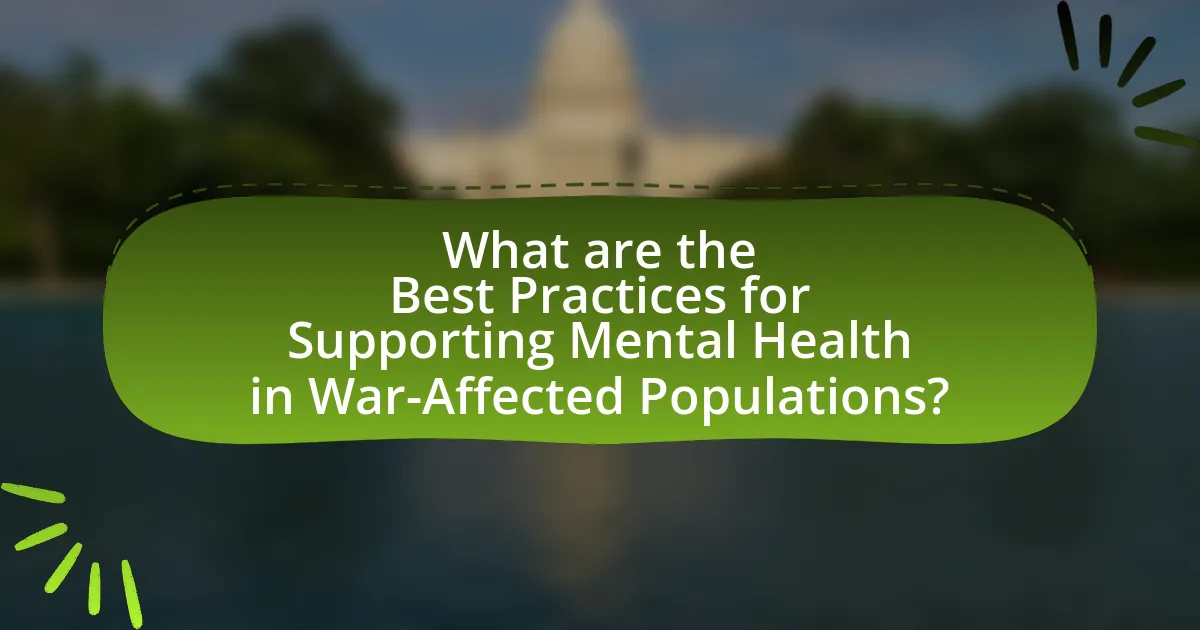
What are the Best Practices for Supporting Mental Health in War-Affected Populations?
Best practices for supporting mental health in war-affected populations include providing trauma-informed care, facilitating access to mental health services, and promoting community resilience. Trauma-informed care recognizes the widespread impact of trauma and emphasizes safety, trustworthiness, and empowerment in treatment. Access to mental health services is critical, as studies show that only a fraction of those in need receive care; for instance, the World Health Organization reports that less than 10% of individuals in low-income countries receive adequate mental health support. Promoting community resilience involves engaging local leaders and fostering social support networks, which can mitigate the effects of trauma and enhance coping strategies. These practices are essential for addressing the complex mental health needs of individuals affected by war.
How can individuals contribute to mental health support for veterans?
Individuals can contribute to mental health support for veterans by volunteering with organizations that provide mental health services, such as the Veterans Affairs (VA) or local non-profits focused on veteran care. These organizations often rely on volunteers for counseling, peer support, and outreach programs. Research indicates that peer support can significantly improve mental health outcomes for veterans, as highlighted in a study published in the Journal of Traumatic Stress, which found that veterans who engaged in peer support reported lower levels of PTSD symptoms. Additionally, individuals can advocate for policies that enhance mental health resources for veterans, thereby influencing systemic change. Engaging in community awareness campaigns also helps reduce stigma surrounding mental health issues in the veteran population, fostering a more supportive environment.
What resources are available for those looking to help?
Resources available for those looking to help include mental health organizations, crisis hotlines, and community support groups. Organizations such as the American Psychological Association provide guidelines and resources for mental health professionals to assist individuals affected by war. Crisis hotlines, like the National Suicide Prevention Lifeline, offer immediate support and guidance. Additionally, community support groups facilitate peer connections and shared experiences, which can be vital for healing. These resources are essential for addressing the mental health impacts of war and providing necessary support to affected individuals.
How can awareness campaigns effectively promote mental health support?
Awareness campaigns can effectively promote mental health support by increasing public knowledge and reducing stigma associated with mental health issues. These campaigns utilize various media platforms to disseminate information about mental health resources, encouraging individuals to seek help. For instance, a study published in the Journal of Medical Internet Research found that social media campaigns significantly improved mental health literacy and reduced stigma, leading to increased help-seeking behaviors among participants. By providing relatable narratives and factual information, awareness campaigns can foster a supportive environment that encourages individuals to prioritize their mental health and access available resources.
What strategies can organizations implement to support mental health?
Organizations can implement several strategies to support mental health, including providing access to mental health resources, promoting a supportive workplace culture, and offering training for managers on mental health awareness. Access to mental health resources, such as counseling services and employee assistance programs, ensures that individuals can seek help when needed. A supportive workplace culture fosters open communication and reduces stigma around mental health issues, encouraging employees to share their struggles. Training for managers equips them with the skills to recognize signs of mental distress and to respond appropriately, creating an environment where employees feel valued and understood. These strategies are supported by research indicating that workplaces that prioritize mental health see improved employee well-being and productivity, as highlighted in studies by the World Health Organization and the American Psychological Association.
How can training programs enhance mental health support services?
Training programs can enhance mental health support services by equipping professionals with essential skills and knowledge to address the unique challenges faced by individuals affected by war. These programs provide evidence-based techniques for trauma-informed care, enabling practitioners to better understand and respond to the psychological impacts of conflict. For instance, a study published in the Journal of Traumatic Stress found that training in trauma-focused cognitive behavioral therapy significantly improved the effectiveness of mental health interventions for veterans. By fostering a deeper understanding of cultural sensitivities and the specific needs of war-affected populations, training programs ultimately lead to more effective and compassionate mental health support services.
What role does peer support play in recovery from war-related mental health issues?
Peer support plays a crucial role in the recovery from war-related mental health issues by providing individuals with shared experiences and emotional understanding. This support system fosters a sense of belonging and reduces feelings of isolation, which are common among veterans and survivors of conflict. Research indicates that peer support can lead to improved mental health outcomes, such as reduced symptoms of PTSD and depression, as it encourages open communication and the sharing of coping strategies. A study published in the Journal of Traumatic Stress found that veterans who engaged in peer support programs reported higher levels of resilience and lower levels of psychological distress, highlighting the effectiveness of this approach in facilitating recovery.
What are the practical steps for advocating mental health awareness?
To advocate for mental health awareness, individuals and organizations can take several practical steps. First, they can organize community events such as workshops, seminars, and support groups to educate the public about mental health issues and available resources. Research indicates that community engagement significantly increases awareness and reduces stigma; for example, a study published in the Journal of Mental Health found that community-based interventions improved knowledge and attitudes towards mental health in 70% of participants.
Second, leveraging social media platforms to share informative content, personal stories, and resources can reach a wider audience. According to a report by the Pew Research Center, 69% of adults in the U.S. use social media, making it an effective tool for spreading awareness.
Third, collaborating with local schools and workplaces to implement mental health programs can foster supportive environments. Evidence from the World Health Organization shows that workplace mental health initiatives can lead to a 30% reduction in absenteeism.
Lastly, advocating for policy changes at local and national levels can enhance mental health services and funding. The National Alliance on Mental Illness emphasizes that legislative advocacy has led to increased funding for mental health programs, demonstrating the impact of collective action.
